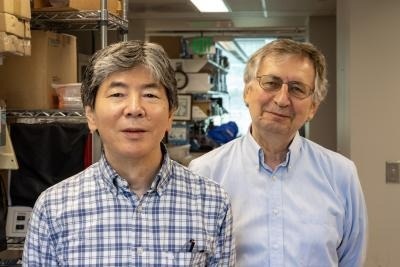As per a research study in mice from the National Eye Institute (NEI) and the University of Freiberg, Germany, the Noelin family belonging to secreted proteins bind to the exterior part of AMPA glutamate receptors and stabilize them on the neuronal cellular membrane. This process is essential for the transmission of full-strength signals among neurons.
 Naoki Nakaya, Ph.D., a co-first author of the study, with Stanislav Tomarev, Ph.D. in the laboratory. Image credit: Dustin Hays, NEI.
Naoki Nakaya, Ph.D., a co-first author of the study, with Stanislav Tomarev, Ph.D. in the laboratory. Image credit: Dustin Hays, NEI.
In the absence of this external, stabilizing protein network, the AMPA receptors are not retained any longer at the synapse, resulting in weak, short-lived synaptic signals. The results not only offer insight into processes like memory and learning but also the development of blinding conditions such as glaucoma. In the journal Neuron, the study was published. NEI is part of the National Institutes of Health.
This study shows that Noelins have a crucial job in supporting synapse function in the brain and other neural tissues like the eye’s retina.”
Stanislav Tomarev, Ph.D., Co-Senior Author and Chief, Section on Retinal Ganglion Cell Biology, National Eye Institute
Neurons transmit signals from one cell to another through synapses, which are dedicated connection points between the two cells. The key excitatory synapses in the brain are glutamatergic, implying that they employ the chemical messenger glutamate to pass their signals through the synapse. The presynaptic “sending” cell releases glutamate, which moves along the synaptic cleft and is detected by glutamate receptors on the postsynaptic “receiving” cell.
Such glutamate receptors are ion channels. They open when the channels sense glutamate, producing a new neuronal signal inside the postsynaptic cell. To produce a powerful signal, adequate receptors need to exist in the right location of the cell’s surface at the synapse.
In a new work, a group of scientists headed by Tomarev and Bernd Fakler, MD, University of Freiberg, employed genetic and biochemical methods to study the complex network of extracellular proteins keeping up the localization of AMPA-type glutamate receptors at neural synapses.
The scientists first took mouse brain tissue and separated cellular membranes and their attached proteins. With specialized analytic techniques and mass spectroscopy, the group worked out which proteins were linked to AMPA receptors in these membranes.
The Noelin family of proteins (majorly Noelin 1, as well as Noelins 2 and 3, also called Olfactomedins 1, 2, and 3, respectively), were efficiently linked to the AMPA receptors. The scientists also identified secreted and membrane-anchored proteins like Neuritin and Brorin, which are known to exist at synapses.
To further understand how the Noelins aid in controlling neuronal activity, the scientists developed mice that do not have all three Noelin proteins. In the lack of Noelins, synapses in the mouse hippocampus had many fewer AMPA glutamate receptors. Also, the neuronal signals were much below normal when the scientists tried to stimulate neurons lacking Noelins.
Nevertheless, the neuronal signals were not just lower. One of the important steps in memory creation is long-term neuron signaling, also called long-term potentiation. This is attained via the stabilization and recruitment of extra glutamate receptors at the synapse after a period, resulting in a sustained signal via the neuron. In the mice’s brains that lack Noelins, this stabilization did not occur, implying that not only were the neural signals low, they were short-lived as well.
While this first study showed the Noelins’ role in the brain, these proteins are highly prevalent in the retina as well “Our next task is to understand how changes in these secreted protein networks contribute to the development of retinal disorders, including glaucoma.”
Stanislav Tomarev, Ph.D., Co-Senior Author and Chief, Section on Retinal Ganglion Cell Biology, National Eye Institute
Source:
Journal reference:
Boudkkazi S, et al. A Noelin-organized extracellular network of proteins required for constitutive and context-dependent anchoring of AMPA-receptors. Neuron. doi:10.1016/j.neuron.2023.07.013